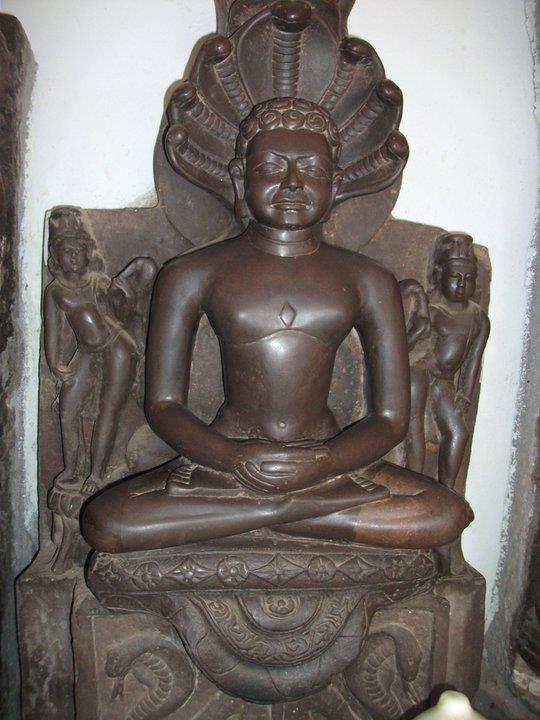
|| ॐ श्री पार्श्वनाथाय नमः ||
Aum Shri Parshvanathaya Namah
Summarized Life of Jina Parshvanatha
Based on Acarya Gunabhadra’s Uttarapurana
Lord Parshvanatha is the 23rd Tirthankara in the Jain tradition. He was born to King Vishvasena and Queen Vasundhara, the rulers of Varanasi. He was born on the 11th day of Pausha. His birth was celebrated with great joy and pomp by his parents and their subjects. Demi gods and other celestial beings also came down to earth to attend this festive occasion.
Young Parshva was a bright, well-informed lad, with a mind of his own and the ability to think for himself. His parents took great care to educate him well and he excelled at all subjects. Once, when he had gone to the forest with his friends, he came across an ascetic who was practising penance and had surrounded himself with five fires. Prince Parshva did not recognise the ascetic as King Mahipala, his mother’s father.
Mahipala, an incarnation of Kamatha, an ancient enemy of Parshva, was enraged that the young prince had not paid him obeisance. He felt that the young Parshva should have paid him obeisance on account of his being an ascetic as well as his maternal grandfather.
When Mahipala got up to chop a log of firewood to replenish his fires, Prince Parshva stopped him saying, “Do not split the log. There are living beings inside it.” A friend of Prince Parshva, Subhaumaka, tried to reason with Mahipala, but to no avail. Mahipala remained obdurate, angry and imbibed great anger and resentment towards Parshva.
Mahipala did not heed the warning and chopped the log in two. As a result, a snake couple, one male and one female, died.
The snake pair was reborn as the King and Queen of snakes, named Dharanendra and Padmavati respectively. They had not forgotten the good turn done to them by Prince Parshva and felt great love and devotion towards him.
As Prince Parshva grew older, he realised the momentariness of worldly relations and the fleeting nature of worldly pleasures. Since he desired eternal bliss, he chose to walk the path of the Jinas.
He gave up his regal home and took the five major vows of a Jain ascetic. He remained immersed in his soul and his meditation was imperturbable.
Once, while monk Parshva was reflecting upon his soul, he was espied by the evil demi-god Shambara, who was the reincarnation of Mahipala. Shambara remembered clearly his humiliation at the hands of Prince Parshva and decided to avenge himself upon the ascetic Parshva.
Through mystical powers, Shambara brought down apocalyptic rains and gales upon the meditating ascetic Parshva. For seven days, he caused frightening thunderstorms and fearsome hailstorms and floods. He did everything possible to break monk Parshva’s concentration and disrupt his meditative state.
Learning of this, King Dharanendra and Queen Padmavati set out to help ascetic Parshva. Dharanendra covered ascetic monk Parshva with his serpent hood while Padmavati raised her hood very high and shielded Parshva from the thunderbolts that Shambara was throwing down at Parshva. Thus, the serpent King and Queen repaid the kindness done to them by Prince Parshva.
After a while, Parshva destroyed his deluding karmas through his meditation and thus, Shambara had to leave. (In truth, it is our negative karmas that harm us, and our positive karmas that help us. Shambara was merely the instrument, the actual cause of Parshva’s discomfort were monk Parshva’s own negative karmas. Parshva realised this and hence felt no resentment towards Shambara.)
Very soon, monk Parshva destroyed all his deluding karmas and attained supreme detachment and omniscience. He thus became Lord Parshvanatha, omniscient, master of the three worlds and supremely detached from them.
Demi gods came down from heaven and joined worldly beings in worshiping the attainment of omniscience by Lord Parshvanatha. There were 700 ascetics in the forest, who belonged to another faith. After learning of Lord Parshvanatha’s omniscience, they came to him and became his disciples.
As time passed by, the evil demi-god Shambara repented his cruel actions and attained true insight.
Lord Parshvanatha would give divine discourses on the platform especially built for this purpose by Indras, the kings of the heavens. Lord Parshvanatha had ten chief disciples and several other highly learned monks as his followers. In all, 16000 Jain monks, 36000 Jain nuns, 100,000 Jain laymen and 300,000 Jain laywomen who became his firm followers. In addition, innumerable celestial beings and countless birds and animals became his disciples.
Lord Parshvanatha would travel and foot and address vast multitudes and give them the true teachings. He did this for nearly 70 years.
In the last month of his life, Lord Parshvanatha stopped traveling and went to Sammeda Shikharji where he remained in meditation. On the 7th day of the bright half of the month of Shravana, he attained liberation.
Victory to Lord Parshvanatha!
We worship Lord Parshvanatha in order to attain his flawless qualities. He was supremely detached, all-knowing and all-seeing. He showed us the true path of liberation. He was the epitome of forbearance and patience. He was impertubable. Nothing and no one could ruffle his inner calm. He was the ideal human being. We idolise him, we must emulate him. Only by following his footsteps will we be able to attain liberation.
|| ॐ श्री पार्श्वनाथाय नमः ||
Aum Shri Parshvanathaya Namah
by Manish Modi
 Manish Modi
Manish Modi